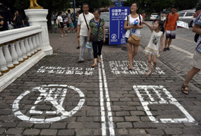 Opps! What a coincidence!
Opps! What a coincidence!
 Breathtaking scenery in Redstone Park in SW China
Breathtaking scenery in Redstone Park in SW China
 Vintage cars show kicks off in London
Vintage cars show kicks off in London
 Gorgeous scenery in NE China
Gorgeous scenery in NE China
 Picturesque Barkol grassland in Xinjiang
Picturesque Barkol grassland in Xinjiang
 Small Wild Goose Pagoda - A World Cultural Heritage Site along the Silk Road
Small Wild Goose Pagoda - A World Cultural Heritage Site along the Silk Road
 Maritime Silk Road Luxuries of the Han Dynasty
Maritime Silk Road Luxuries of the Han Dynasty
 Ciao! Chinese beauties!
Ciao! Chinese beauties!
 An eye feast: BFA freshmen registration
An eye feast: BFA freshmen registration
 Top 10 most lavish weddings
Top 10 most lavish weddings
BEIJING, Sept. 28 -- China will promote the application of satellite earth observation technologies to better serve the economy, officials and experts said.
China has already built a network of satellites and other facilities for earth observation in pursuing its space programs including manned space navigation, lunar probe and Beidou navigation system, but officials said much remains to be done in the actual application of the technology.
Remote sensing via satellites and other technology has played an important role in the national economic and social development, said Xu Dazhe, head of the State Administration of Science, Technology and Industry for National Defence at a recent conference.
The administration will promote the construction of a high-definition earth observation system and the spatial data infrastructure, he said.
It plans to spend ten years in constructing an earth observation system that integrates use of air, space and ground based technology, including drones, satellites and GPS systems, in order to serve the economic and social development.
"China's remote sensing application has been undergoing a rapid development. China's remote sensing satellites have been developed from the phase of experimental application to business service," Luo Ge, an official with the State Administration of Science, Technology and Industry for National Defence, said
He said the number of China's satellites and the quality of the pictures and data taken by the satellites have been greatly improved.
On August 19, China successfully launched its most advanced earth observation satellite, the Gaofen-2, which is able to see a one-meter-long object from space in full color.
The Gaofen-2 is the second of seven satellites to be launched for China's indigenous high-definition observation project Gaofen before 2020. The project was initiated in May 2010.
Gaofen-1, the first satellite of the project, was launched in April 2013.
Luan Enjie, an academic at the Chinese Academy of Engineering, said in the area of remote sensing, China has largely relied on foreign satellites, while the launching of Gaofen-1 and Gaofen-2 satellites means the country has entered a new era of independently developing high-definition satellites.
Gu Xingfa, expert with the Chinese Academy of Sciences, said China will launch more high-definition remote sensing satellites in the near future, gradually promote the application of the remote sensing satellites, and reduce its dependence on foreign satellites.
 Jungle law: leopard preys on impala
Jungle law: leopard preys on impala Female bus driver drives Land Rover for commuting
Female bus driver drives Land Rover for commuting Top 3 iOS 8 features Chinese love most
Top 3 iOS 8 features Chinese love most Century-old public bath closes door in Beijing
Century-old public bath closes door in Beijing Teahouses in Chongqing: Worship to the leisure lifestyle
Teahouses in Chongqing: Worship to the leisure lifestyle Leading director Wang Quan'an detained for 'buying sex'
Leading director Wang Quan'an detained for 'buying sex' Mixed reaction to smartphone sidewalk
Mixed reaction to smartphone sidewalk Amazing aerial photos of China's Xisha Islands
Amazing aerial photos of China's Xisha Islands Top 10 world's highest-paid models 2014
Top 10 world's highest-paid models 2014 Lingerie show at 2014 Miss China
Lingerie show at 2014 Miss China Songstress Li Xianglan dies at 94
Songstress Li Xianglan dies at 94 Police recruiting posters
Police recruiting posters Anshun Daxi- Living fossil of Chinese drama
Anshun Daxi- Living fossil of Chinese drama Urban farmers in China
Urban farmers in China 'Firepower-2014 Weibei'military exercise
'Firepower-2014 Weibei'military exerciseDay|Week|Month